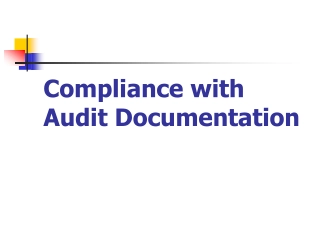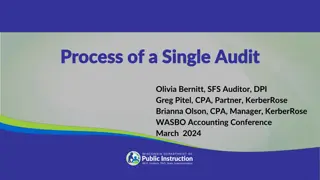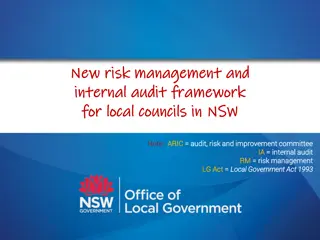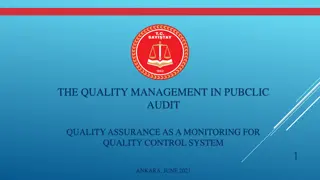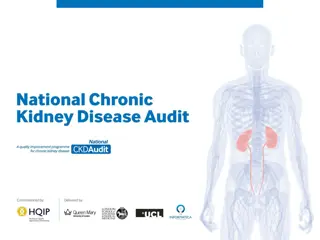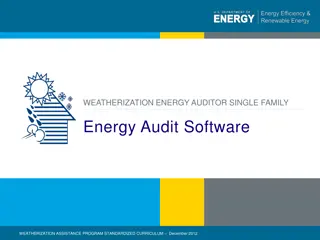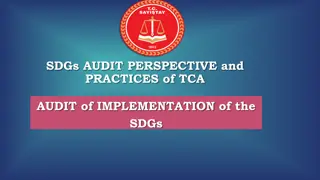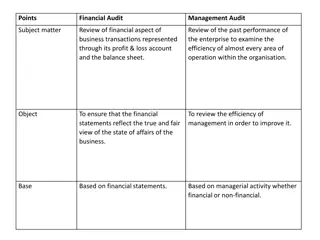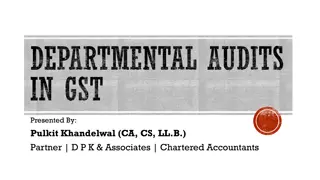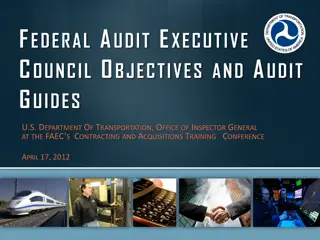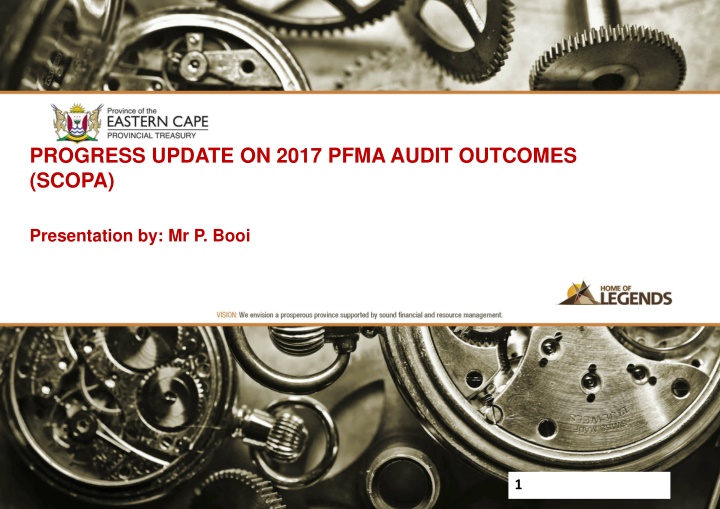
Progress Update on 2017 PFMA Audit Outcomes Presentation
Get insights into the 2017 PFMA audit outcomes as presented by Mr. P. Booi to SCOPA. Discover the audit improvement strategy and key highlights for better governance.
Download Presentation

Please find below an Image/Link to download the presentation.
The content on the website is provided AS IS for your information and personal use only. It may not be sold, licensed, or shared on other websites without obtaining consent from the author. If you encounter any issues during the download, it is possible that the publisher has removed the file from their server.
You are allowed to download the files provided on this website for personal or commercial use, subject to the condition that they are used lawfully. All files are the property of their respective owners.
The content on the website is provided AS IS for your information and personal use only. It may not be sold, licensed, or shared on other websites without obtaining consent from the author.
E N D
Presentation Transcript
PROGRESS UPDATE ON 2017 PFMA AUDIT OUTCOMES (SCOPA) Presentation by: Mr P. Booi 1
Contents Purpose. Executive Summary Overview of the Audit outcomes. 2017 Audit Outcomes. Audit Improvement Strategy. 2
Purpose To brief the SCOPA on the 2017 PFMA Audit Outcomes as well as to highlight actions identified by Treasury to improve the situation. 3
Executive Summary (1 of 2). After stagnating from 2013/14 financial year improvements, there are notable improvements in the 2016/17 financial year, PFMA audit outcomes. o Only Education is qualified and all other entities (13 departments and 11 public entities) are unqualified. o This include 10 entities achieving clean audit (reflecting an increase of 2 entities) from the previous financial year. o This is good in managing perceptions on the capacity of the state. o Lays good foundation for translating good audit performance to service delivery. The trick is on sustaining improvements going forward. o Experience still indicate a lot of negotiating changes in the financial statements and AG extending its flexibility in allowing changes to improve audit evidence. o Capacity challenges in DRPW are yet to stabilise there is still heavy reliance on consultants. o It is encouraging to note that those departments that achieve unqualified audit outcomes tend to maintain this outcome. o There is hope that these will be maintained as we get Education towards unqualified status in the next two years. 4
Executive Summary (2 of 2). Treasury will continue to support departments on financial management maturity so that good audit outcomes are a natural feature. o NT and PT are collaborating on and Integrated Support Programme to build capacity, as identified from departmental SWOT analysis. To be used to benchmark with current support programmes o Treasury continues to review its oversight strategies for better effectiveness. Just developed the Oversight Framework for Treasuries (CFO functions) to complement the FMAF. Just reviewed the Financial Management Accountability Framework(FMAF), with in-year implementation of consequence management to create the culture necessary for FM maturity. Working on CFO Capacitation Framework to secure minimum standards on recruitment, development & retention of staff in the CFO function. There are plans to evaluate successes in Health to see if these can document them as best practices. o Financial Management Capacity Study is being rolled out to departments. o There is heightened activity in the IFMS project for better integration of systems, with added benefits on the data integrity, turnaround times in accessing information for decision making and managing fraud. 5
Summary of provincial audit opinions for provincial departments The diagram below summarizes audit opinions for the previous 6 year period. Departments Unqualified with no findings Unqualified with findings Qualified Disclaimer 2017 2016 2015 2014 2013 2012 - 3 2 2 9 3 3 8 3 2 7 4 1 10 1 11 1 8 5 1 - - - - 7
Summary of provincial audit opinions for public entities The diagram below summarizes audit opinions for the previous 6 year period. Public Entities Unqualified with no findings Unqualified with findings Qualified Disclaimer 2017 2016 2015 2014 2013 2012 - 7 4 6 5 2 7 2 1 7 3 1 2 6 2 2 9 1 - - - - - - 8
2017 Audit Outcomes for Provincial Departments For the 2016/17 financial year, the PFMA audit outcomes were as follows: Clean audit: o Three (3) departments i.e. Provincial Treasury, Rural Development and Agrarian Reform and Safety & Liaisons. Unqualified audit opinion with other matters: o Ten (10) departments i.e. Office of the Premier; Legislature; Social Development; Cooperative Government and Traditional Affairs; Economic Development, Environmental Affairs & Tourism, Transport ,Human Settlement; Sports, Recreation, Arts & Culture; Health and Roads, & Public Works. Qualified opinion: o One (1) departments i.e., Education All (11) Public Entities are unqualified, with 7 attaining Clean Audit i.e. o ECSECC; ECPACC; ECGBB;ECRDA; ECPTA; ELIDZ; ECLB and four receiving unqualified opinion with other matters i.e. CDC; Mayibuye Transport Corporation; Government Fleet Trading Entity and ECDC. 10
Transversal findings Inadequate supporting documents (Document management) Accruals and commitments (Completeness and Accuracy) Disclosure of Fruitless and Wasteful (Completeness) Disclosure of Irregular Expenditure (Completeness) Asset management Misstatements Non compliance with Treasury regulations and procurement processes Performance Information (Completeness, Accuracy, Usefulness, Relevance, Reliability) 11
Drivers for negative findings The following are major causes for the findings that negatively affect the audit outcomes: o Capacity, indicated by long period of vacancies in the leadership positions of some departments and which results in lapses in internal controls. o The vacancies in leadership positions result in those positions being filled by people in acting capacities, which compromises issues of accountability. o Commitments that cannot be verified owing to records not being available. o Irregular expenditure that are not prevented and identified, resulting in huge balances that remain un- cleared for a number of years. There are other general challenges that can be addressed by adopting a project management approach to the audit process, sustained by a discipline in executing accounting routines and close supervision by the Chief Financial Officers (CFOs). 12
Improvement of the Provincial Audit Outcomes (1 of 2) Audit improvement (which is part of the POA) is managed through a range of measures o Commitments by departments on improving the audit (AIPs) and which aggregated into the PAIP. Implement systems of internal controls and strengthening governance Adopting a project management approach to the audit o Raising the oversight and leadership capability HOD positions is not vacant for more than three months. CFO vacancy and support positions (up to 3rd tear management) below the CFO not vacant for more than three months. Support is given for MEC to oversee key financial management indicators. Engagements with Auditor General Communication platforms are maintained and strengthened for better appreciation of FM risks and management thereof. o CFO forum and Provincial Management o CAE, CRO Forum and ACC Forum o Provincial Audit Steering Committee Forum o Reports to EXCO o Reports to Legislature. Co-ordinate the annual reporting and the audit processes. o Support departments in designing AIPs and clear any disputes within government departments/entities and between government and the Auditor General. o Refresh the understanding of guidelines through workshops, continual readiness assessments against the Reporting Schedule and sharing of risks and mitigation measures. o Review of the Interim Financial Statements in line with the guidelines o Review the Annual Reports in line with the APP. 14
Improvement of the Provincial Audit Outcomes (2 of 2) Strengthen Governance (Internal Audit, Risk Management and Fraud Prevention) o Review the function of the following structures against norms, focusing on: Vacancies Training support, in particular continuing professional training . Quality assurance Implement Accountability Model to promote discipline in managing public resources. o MEC outreach programmes are conducted quarterly o Presentations are made to the PCMT These measurers are complemented by sustained focus on financial management maturity and overall governance. o Financial Management Capacity will be assessed regularly (Review of CFO structures, business processes and recommending improvements) to support HR plans and business processes in the CFO environment. Improvements in the Supply Chain Management (planning and contract management) and Asset Management (planning, acquisition, safe custody, valuation, maintenance and disposal). o LOGIS Roll out to support Procurement, Accounting and Asset Management o Document management system to support Accounting and Fraud Prevention/Detection. o Reforms on the FIS (driven by National Treasury) o Strengthening Risk Management and Internal Audit There needs to be a continuous effort to improve the audit, translating the lessons from the previous audit to the next audit cycle. 15
Approach in managing the audit risks The inadequate financial management capacity and malicious compliance culture (most departments do not comply with the principles and some even submitted late) limits the full benefits of the Provincial Audit Improvement Plan. Treasury mitigates these risks by having one on one meetings with departments, focusing on those that had qualified audits. Clear targets in improving audit outcomes are shared upfront with the provincial entities so that plans are informed by such targets. CFO Forums and engagements with AGSA are used to manage issues that cut across all departments (e.g. irregular expenditure and accounting for Trading Entity, etc). Sharing progress with EXCO regularly (to bring them to speed and to guide their oversight). Treasury initiated special projects to support departments resolve long outstanding issues, like clearing irregular expenditure (first target set for 31 March 2015). 16 16
Special projects to support audit improvement (1 of 4). Audit Improvement Plan. Treasury has developed a template for developing Audit Improvement Plans (AIPs) in order to transfer lessons to the next audit cycle where these cannot be implemented in the current year. The AIP guidelines in the main seeks to drive the following principles: o AIP must have full coverage of the audit issues, targeting the root causes (not symptoms) and covering the entire population o AIP must be broken down to clear milestones, responsibilities, and indicators to facilitate monitoring during its implementation . o Commitments or measures to address key controls must be reasonable. o AIP must be resourced with people with the right level of influence to ensure that commitments are implemented and that AIP has prospects of turning around the negative audit opinion. o The AIP must be quality reviewed by the Chief Financial Officer, who is also charged to champion its implementation. 17 17
Special projects to support audit improvement (2 of 4). Milestones on the Audit Process. One of the major milestones in the audit process (detailed in the Reporting Schedule) is the start of the audit process in (January/February, every year), when AGSA starts with planning. Departments are always advised to capitalise on the planning meetings with AGSA, focusing on the following: o Agreement on the time frames for planning, field work or end of execution to plan the resourcing of the audit process. o Agreement on minimum meeting dates to allow easy flow and give early warning on how the audit is progressing. o Agreement on how flow of documentation is to recorded/acknowledged. o Clarity on the Audit Champion (person assigned to manage the audit responses for adequacy and turnaround times) o Clarity on possible interpretation issues that may arise during the audit (e.g. accounting, verification and valuations of complex assets like underground cables, etc). o Assessing any changes (new developments) on audit procedures that may impact on the audit (consistency on interpretation of technical issues), including the impact caused by introduction of new members in the audit team (which needs to managed by induction of such members for better understanding of the audit environment). o Agree on the audit focus (e.g. districts to be audited and whether the AGSA would be auditing in the districts or the information must be submitted in HO) o For Departments with the districts there must be adequate training of District Audit Champions in terms of the standards agreed to and how the district must be made ready for the audit 18 18
Special projects to support audit improvement (3 of 4). Clearance of Irregular Expenditure (IE) PT has been supporting departments to reduce IE balances through following the correct condonation channels. IE incurred reduced by R163 million (from R1.2 billion in 2015/16 to R989 million in 2016/17). Secondly the total Irregular Expenditure value (including prior years) decreased by R420 million. A bigger margin of decrease would have occurred if not for the increase in prior year irregular expenditure resulting from a restatement of prior year figures by R1.1 billion in the Department of Education. 19 19
Special projects to support audit improvement (3 of 3). Clearance of Irregular Expenditure (IE) Restatement of IE in DoE In line with the recommendation by the AGSA, the Department embarked on a project to verify the validity and completeness of irregular expenditure for the years 2013/14 to 2015/16 by reviewing all available expenditure documentation. This resulted in the restatement and an increase in the value of irregular expenditure previously disclosed in prior years. This exercise is however completed and the department is in the process of applying for condonation of all irregular expenditure disclosed which will reduce rather increase in value 20 20
DISCUSSIONS 21

